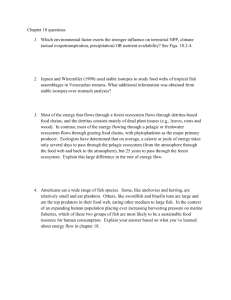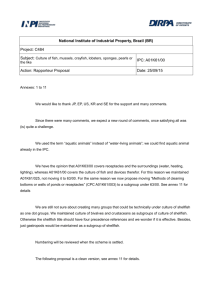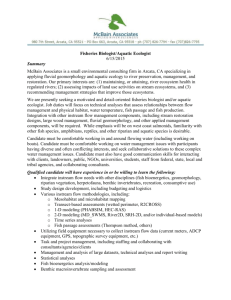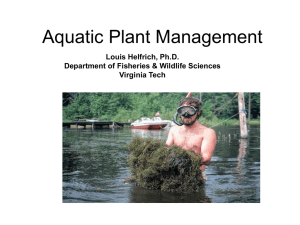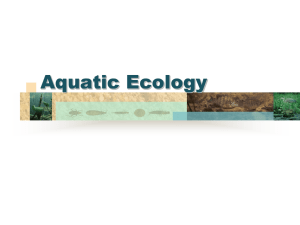Pollution Information Sheet
advertisement
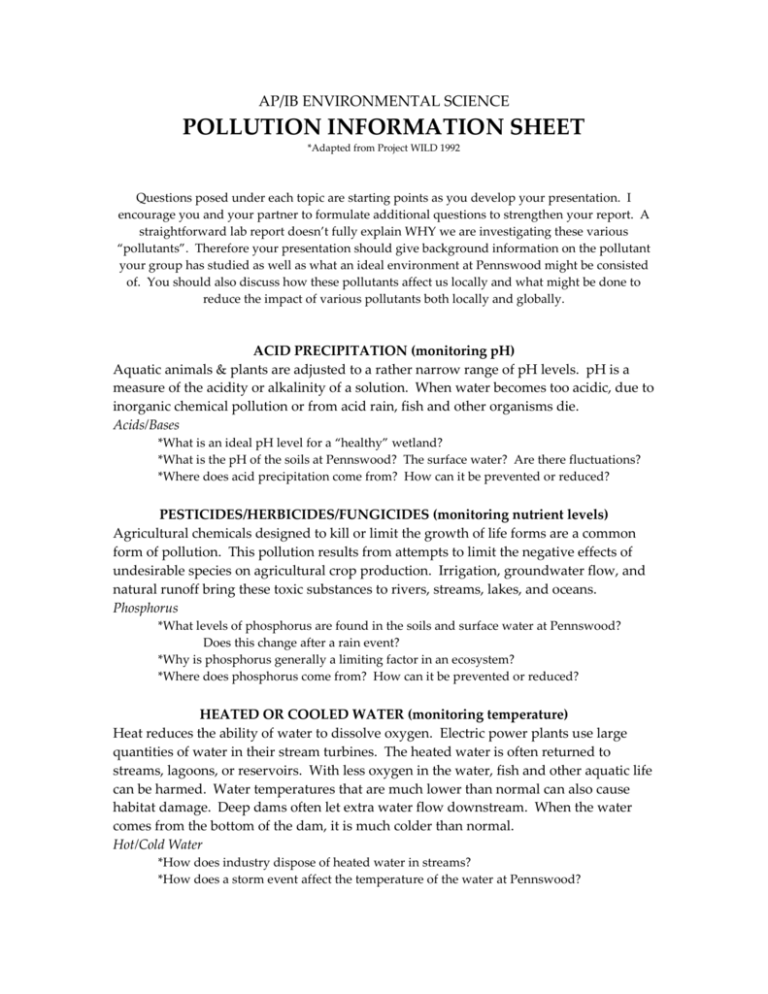
AP/IB ENVIRONMENTAL SCIENCE POLLUTION INFORMATION SHEET *Adapted from Project WILD 1992 Questions posed under each topic are starting points as you develop your presentation. I encourage you and your partner to formulate additional questions to strengthen your report. A straightforward lab report doesn’t fully explain WHY we are investigating these various “pollutants”. Therefore your presentation should give background information on the pollutant your group has studied as well as what an ideal environment at Pennswood might be consisted of. You should also discuss how these pollutants affect us locally and what might be done to reduce the impact of various pollutants both locally and globally. ACID PRECIPITATION (monitoring pH) Aquatic animals & plants are adjusted to a rather narrow range of pH levels. pH is a measure of the acidity or alkalinity of a solution. When water becomes too acidic, due to inorganic chemical pollution or from acid rain, fish and other organisms die. Acids/Bases *What is an ideal pH level for a “healthy” wetland? *What is the pH of the soils at Pennswood? The surface water? Are there fluctuations? *Where does acid precipitation come from? How can it be prevented or reduced? PESTICIDES/HERBICIDES/FUNGICIDES (monitoring nutrient levels) Agricultural chemicals designed to kill or limit the growth of life forms are a common form of pollution. This pollution results from attempts to limit the negative effects of undesirable species on agricultural crop production. Irrigation, groundwater flow, and natural runoff bring these toxic substances to rivers, streams, lakes, and oceans. Phosphorus *What levels of phosphorus are found in the soils and surface water at Pennswood? Does this change after a rain event? *Why is phosphorus generally a limiting factor in an ecosystem? *Where does phosphorus come from? How can it be prevented or reduced? HEATED OR COOLED WATER (monitoring temperature) Heat reduces the ability of water to dissolve oxygen. Electric power plants use large quantities of water in their stream turbines. The heated water is often returned to streams, lagoons, or reservoirs. With less oxygen in the water, fish and other aquatic life can be harmed. Water temperatures that are much lower than normal can also cause habitat damage. Deep dams often let extra water flow downstream. When the water comes from the bottom of the dam, it is much colder than normal. Hot/Cold Water *How does industry dispose of heated water in streams? *How does a storm event affect the temperature of the water at Pennswood? *Can water be too cold for an ecosystem? What are ideal temperatures? SEDIMENTS (monitoring the impact of development) Particles of soil, sand, silt, clay and minerals wash from land and paved areas into creeks and tributaries. In large unnatural quantities these natural materials can be considered a pollutant. Construction projects often contribute large amounts of sediment. Certain lumbering practices affect sediments in runoff. Sediments may fill stream channels and harbors that later require dredging. Sediments suffocate fish and shellfish populations by covering fish nests and clogging the gills of bottom fish and shellfish. Gravel/Road Debris *How has development in Lower Bucks County increased sediment flow? What is the role of erosion? *What is the benefit of porous pavement in development? *What are the most difficult sediments to control? PETROLEUM PRODCUTS (monitoring the impact of industrialization) Oil and other petroleum products like gasoline and kerosene can find their way into water from ships, oil drilling rigs, oil refineries, automobile service stations, and streets. Oil spills kill aquatic life (fish, birds, shellfish, and vegetation). Birds are unable to fly when oil loads the feathers. Shellfish and small fish are poisoned. If it is washed on the beach, the oil requires much labor to clean it up. Fuel oil, gasoline and kerosene may leak into the ground water through damaged storage tanks. Petroleum Products *How has development in Lower Bucks County increased the input of petroleum? *How difficult is it to remove petroleum products from a damaged ecosystem? What are the impacts on aquatic life? *Plants store energy in oils. Do human processing impact plant oils in an ecosystem? ANIMAL WASTES/FERTILIZERS (monitoring nutrient levels and agriculture) The major source of pollution from agriculture comes from surplus fertilizers in the runoff. Fertilizers contain nitrogen and phosphorous that can cause large amounts of algae to grow. They large algae blooms cover the water surface. The algae die after they have used all of the nutrients. Once dead, they sink to the bottom where bacteria feed on them. The bacterial populations increase and use up most of the oxygen in the water. Once the free oxygen is gone, many aquatic animals die. This process is called eutrophication. Algae—to simulate eutrophication *What are the main nutrients in many commercially made fertilizers? *Do the levels of dissolved oxygen affect wetlands in the same way they affect streams? *Are there situations where algae has created a dead zone in a previously healthy ecosystem? INORGANIC COMPOUNNDS (monitoring the impact of mining) Inorganic chemicals and mineral substances, solid matter, and metal salts commonly dissolve into water. They often come from metal salts commonly dissolve into water. They often come from mining and manufacturing industries, oil field operations, agriculture, and natural sources. These chemicals interfere with natural stream purification; they destroy fish and other aquatic life. They also corrode expensive water treatment equipment and increase the cost of boat maintenance. Metal Salts *What types of metals are considered toxic to fish? What metals are prevalent in Eastern Pennsylvania? *Typha and other aquatic plants take up metals in their tissues. What are the implications of this if we harvest typha for biomass?
